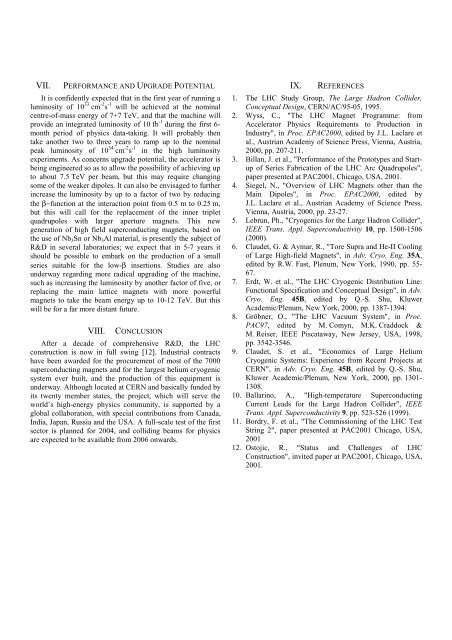preliminary - Bad Request - Cern
preliminary - Bad Request - Cern
preliminary - Bad Request - Cern
Create successful ePaper yourself
Turn your PDF publications into a flip-book with our unique Google optimized e-Paper software.
VII. PERFORMANCE AND UPGRADE POTENTIAL<br />
It is confidently expected that in the first year of running a<br />
luminosity of 10 33 cm -2 s -1 will be achieved at the nominal<br />
centre-of-mass energy of 7+7 TeV, and that the machine will<br />
provide an integrated luminosity of 10 fb -1 during the first 6month<br />
period of physics data-taking. It will probably then<br />
take another two to three years to ramp up to the nominal<br />
peak luminosity of 10 34 cm -2 s -1 in the high luminosity<br />
experiments. As concerns upgrade potential, the accelerator is<br />
being engineered so as to allow the possibility of achieving up<br />
to about 7.5 TeV per beam, but this may require changing<br />
some of the weaker dipoles. It can also be envisaged to further<br />
increase the luminosity by up to a factor of two by reducing<br />
the β−function at the interaction point from 0.5 m to 0.25 m,<br />
but this will call for the replacement of the inner triplet<br />
quadrupoles with larger aperture magnets. This new<br />
generation of high field superconducting magnets, based on<br />
the use of Nb3Sn or Nb3Al material, is presently the subject of<br />
R&D in several laboratories; we expect that in 5-7 years it<br />
should be possible to embark on the production of a small<br />
series suitable for the low-β insertions. Studies are also<br />
underway regarding more radical upgrading of the machine,<br />
such as increasing the luminosity by another factor of five, or<br />
replacing the main lattice magnets with more powerful<br />
magnets to take the beam energy up to 10-12 TeV. But this<br />
will be for a far more distant future.<br />
VIII. CONCLUSION<br />
After a decade of comprehensive R&D, the LHC<br />
construction is now in full swing [12]. Industrial contracts<br />
have been awarded for the procurement of most of the 7000<br />
superconducting magnets and for the largest helium cryogenic<br />
system ever built, and the production of this equipment is<br />
underway. Although located at CERN and basically funded by<br />
its twenty member states, the project, which will serve the<br />
world’s high-energy physics community, is supported by a<br />
global collaboration, with special contributions from Canada,<br />
India, Japan, Russia and the USA. A full-scale test of the first<br />
sector is planned for 2004, and colliding beams for physics<br />
are expected to be available from 2006 onwards.<br />
IX. REFERENCES<br />
1. The LHC Study Group, The Large Hadron Collider,<br />
Conceptual Design, CERN/AC/95-05, 1995.<br />
2. Wyss, C., "The LHC Magnet Programme: from<br />
Accelerator Physics Requirements to Production in<br />
Industry", in Proc. EPAC2000, edited by J.L. Laclare et<br />
al., Austrian Academy of Science Press, Vienna, Austria,<br />
2000, pp. 207-211.<br />
3. Billan, J. et al., "Performance of the Prototypes and Startup<br />
of Series Fabrication of the LHC Arc Quadrupoles",<br />
paper presented at PAC2001, Chicago, USA, 2001.<br />
4. Siegel, N., "Overview of LHC Magnets other than the<br />
Main Dipoles", in Proc. EPAC2000, edited by<br />
5.<br />
J.L. Laclare et al., Austrian Academy of Science Press,<br />
Vienna, Austria, 2000, pp. 23-27.<br />
Lebrun, Ph., "Cryogenics for the Large Hadron Collider",<br />
IEEE Trans. Appl. Superconductivity 10, pp. 1500-1506<br />
(2000).<br />
6. Claudet, G. & Aymar, R., "Tore Supra and He-II Cooling<br />
of Large High-field Magnets", in Adv. Cryo. Eng. 35A,<br />
edited by R.W. Fast, Plenum, New York, 1990, pp. 55-<br />
67.<br />
7. Erdt, W. et al., "The LHC Cryogenic Distribution Line:<br />
Functional Specification and Conceptual Design", in Adv.<br />
Cryo. Eng. 45B, edited by Q.-S. Shu, Kluwer<br />
8.<br />
Academic/Plenum, New York, 2000, pp. 1387-1394.<br />
Gröbner, O., "The LHC Vacuum System", in Proc.<br />
PAC97, edited by M. Comyn, M.K. Craddock &<br />
9.<br />
M. Reiser, IEEE Piscataway, New Jersey, USA, 1998,<br />
pp. 3542-3546.<br />
Claudet, S. et al., "Economics of Large Helium<br />
Cryogenic Systems: Experience from Recent Projects at<br />
CERN", in Adv. Cryo. Eng. 45B, edited by Q.-S. Shu,<br />
Kluwer Academic/Plenum, New York, 2000, pp. 1301-<br />
1308.<br />
10. Ballarino, A., "High-temperature Superconducting<br />
Current Leads for the Large Hadron Collider", IEEE<br />
Trans. Appl. Superconductivity 9, pp. 523-526 (1999).<br />
11. Bordry, F. et al., "The Commissioning of the LHC Test<br />
String 2", paper presented at PAC2001 Chicago, USA,<br />
2001<br />
12. Ostojic, R., "Status and Challenges of LHC<br />
Construction", invited paper at PAC2001, Chicago, USA,<br />
2001.















